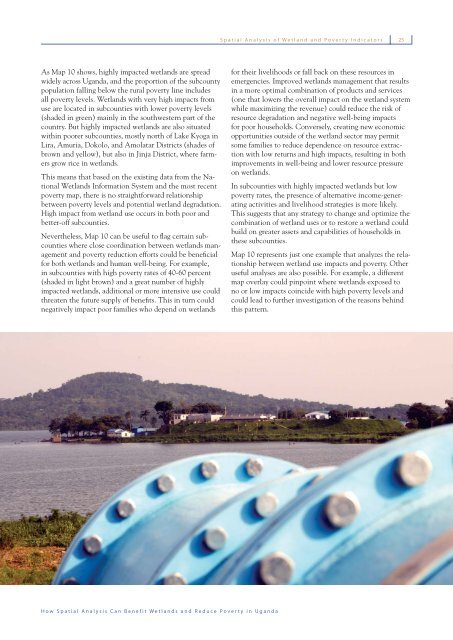Mapping a Better Future - World Resources Institute
Mapping a Better Future - World Resources Institute
Mapping a Better Future - World Resources Institute
Create successful ePaper yourself
Turn your PDF publications into a flip-book with our unique Google optimized e-Paper software.
Spatial Analysis of Wetland and Poverty Indicators<br />
25<br />
As Map 10 shows, highly impacted wetlands are spread<br />
widely across Uganda, and the proportion of the subcounty<br />
population falling below the rural poverty line includes<br />
all poverty levels. Wetlands with very high impacts from<br />
use are located in subcounties with lower poverty levels<br />
(shaded in green) mainly in the southwestern part of the<br />
country. But highly impacted wetlands are also situated<br />
within poorer subcounties, mostly north of Lake Kyoga in<br />
Lira, Amuria, Dokolo, and Amolatar Districts (shades of<br />
brown and yellow), but also in Jinja District, where farmers<br />
grow rice in wetlands.<br />
This means that based on the existing data from the National<br />
Wetlands Information System and the most recent<br />
poverty map, there is no straightforward relationship<br />
between poverty levels and potential wetland degradation.<br />
High impact from wetland use occurs in both poor and<br />
better-off subcounties.<br />
Nevertheless, Map 10 can be useful to fl ag certain subcounties<br />
where close coordination between wetlands management<br />
and poverty reduction efforts could be benefi cial<br />
for both wetlands and human well-being. For example,<br />
in subcounties with high poverty rates of 40-60 percent<br />
(shaded in light brown) and a great number of highly<br />
impacted wetlands, additional or more intensive use could<br />
threaten the future supply of benefi ts. This in turn could<br />
negatively impact poor families who depend on wetlands<br />
for their livelihoods or fall back on these resources in<br />
emergencies. Improved wetlands management that results<br />
in a more optimal combination of products and services<br />
(one that lowers the overall impact on the wetland system<br />
while maximizing the revenue) could reduce the risk of<br />
resource degradation and negative well-being impacts<br />
for poor households. Conversely, creating new economic<br />
opportunities outside of the wetland sector may permit<br />
some families to reduce dependence on resource extraction<br />
with low returns and high impacts, resulting in both<br />
improvements in well-being and lower resource pressure<br />
on wetlands.<br />
In subcounties with highly impacted wetlands but low<br />
poverty rates, the presence of alternative income-generating<br />
activities and livelihood strategies is more likely.<br />
This suggests that any strategy to change and optimize the<br />
combination of wetland uses or to restore a wetland could<br />
build on greater assets and capabilities of households in<br />
these subcounties.<br />
Map 10 represents just one example that analyzes the relationship<br />
between wetland use impacts and poverty. Other<br />
useful analyses are also possible. For example, a different<br />
map overlay could pinpoint where wetlands exposed to<br />
no or low impacts coincide with high poverty levels and<br />
could lead to further investigation of the reasons behind<br />
this pattern.<br />
How Spatial Analysis Can Benefit Wetlands and Reduce Poverty in Uganda

















